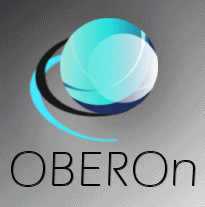how to control the object instance behaviour with a lifecycle
Business objects may have methods, rules, states as
ways to describe the actions that can be performed with them. You
cannot create an object instance in OBEROn without specify what
is its behaviour inside the application environment. The object
behaviour depends in part from the object type (or class) but mainly
from the lifecycle associated to it. A lifecycle controls a business
object: it specifies the rules that govern user access, validations,
state transitions, revision rules, type of attachments, documents
and so on. If you want to know what a user can do with a business
object, you should look at the object’s lifecycle.
In details, a lifecycle includes all the following
information:
• The object classes that may be subjected to it
• The types of documents (filetypes) that are allowed
for objects associated with this lifecycle
and the default filetype automatically used
• The filespace where these files are stored into
• The revision rule that defines the labels in the revision
sequence
... and some options :
| |
Check update |
This option enables/disables the synchronization counter for object instance updates: the object internal counter is increased after each modification, in case of the read counter doesn't match the current value during the update operation an exception is raised |
| |
Undo |
This option enables/disables the rollback of edit operations for object instances |
| |
Add To Recent |
Every time a user opens an object and reads its information,
the object is added to a user own objectgroup called "Recent_Objects"
(automatically created if not exists). This flag overrides the same flags activated or not on single stages. |
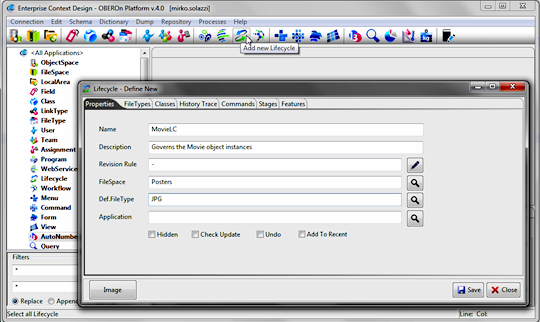
The revision rule is an expression composed of positional digits
(symbols) and separator characters.
|
Symbol
|
Description |
|
1,2,3,4,5,
6,7,8,9
|
digits from 0 to N [ ex: 1 = (0,1) binary ; 7
= (0,1,2,3,4,5,6,7) octal ; 9 = (0,1,...,8,9) decimal ] |
|
x
|
hex digits with lower case letters (0,..9,a,b,c,d,e,f) |
|
X
|
hex digits with upper case letters (0,..9,A,B,C,D,E,F) |
|
a
|
lower case alphabetic characters (a,b,c,d,....,x,y,w,z) |
|
A
|
upper case alphabetic characters (A,B,C,D,....,X,Y,W,Z) |
|
z
|
lower case alphanumeric characters (0,1,..,9,a,b,c,d,....,x,y,w,z) |
|
Z
|
upper case alphanumeric characters (0,1,..,9,A,B,C,D,....,X,Y,W,Z) |
|
o
|
unlimited lower case english literal numbers
(one,two,three,four,..........) |
|
O
|
unlimited upper case english literal numbers
(ONE,TWO,THREE,FOUR,..........) |
|
l
|
limited lower case english literal numbers (one,two,three,four,...,nine,ten) |
|
L
|
limited upper case english literal numbers (ONE,TWO,THREE,FOUR,...,NINE,TEN) |
|
i
|
unlimited lower case roman numbers (i,ii,iii,iv,v,vi,vii,viii,ix,x,xi...) |
|
I
|
unlimited upper case roman numbers (I,II,III,IV,V,VI,VII,VIII,IX,X,XI...) |
|
r
|
limited lower case roman numbers (i,ii,iii,iv,v,vi,vii,viii,ix,x) |
|
R
|
limited upper case roman numbers (I,II,III,IV,V,VI,VII,VIII,IX,X) |
| |
|
| Separator characters: !£$%&/()=?^*+°§<>;,:._-#@[]{}€
and space |
The first revision is obtained by replacing every positional
symbols with the first item in the corresponding sequences. The
next revisions are computed by incrementing the most right symbol;
when the digit sequence reaches the last element the rest is propagated
to the other digits on the left, as in a usual positional number
system.
For example the sequence generated from the rule R/2
will be:
I/0 I/1 I/2 II/0 II/1 II/2 III/0
III/1 III/2 IV/0 IV/1 IV/2 .......
IX/0 IX/1 IX/2 X/0 X/1 X/2
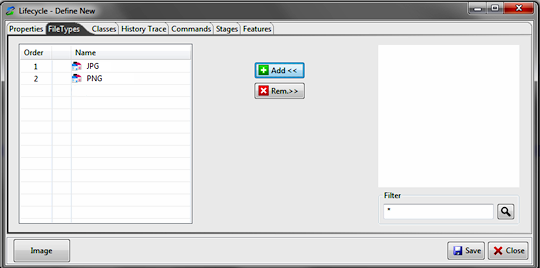
When you add a class under the lifecycle control, all derived classes
in the class-hierarchy automatically will be subjected to it and
it is not necessary to add all of them.
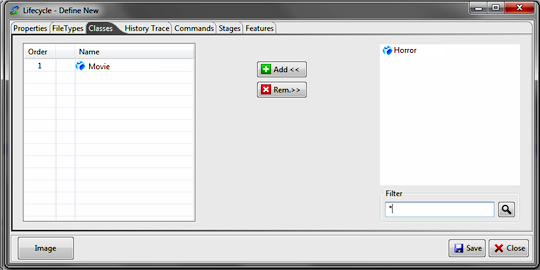
Moreover a lifecycle consists of a series of linked stages,
each of which represents a state in the life of the governed objects
and includes the following information:
• Who will have access to the object when it is in this
stage
• What actions will be registered into the object history
• If the object can be revised (revisionable condition)
• The conditions required for changing state
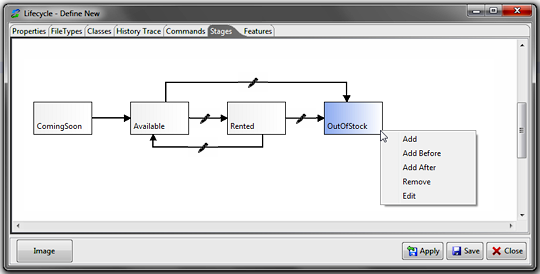
A lifecycle may have one or more stages. This number
depends from the type of objects it governs. For example, you might
have a lifecycle for a static object that represents a company:
you can update its information data like the name, the address,
the telephone number, but it never changes its state. In this situation,
you might have only one stage where access to modify this information
is well defined.
To add a new stage simply click with the mouse right-button inside
the drawing area; this stage will be appended to the end of the
sequence. Otherwise, if you want to insert a new stage before or
after another just select the reference stage and click over it.
As soon as you add a new stage this takes a progressive name (Stage_1,
Stage_2 ...); with a mouse double click over it, you can edit the
stage properties included the stage name and description.
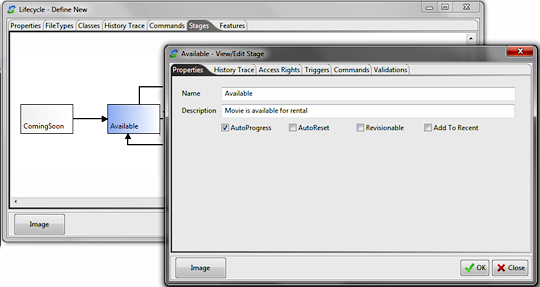
The access level for each stage is characterized by
different conditions. The lifecycle allows the user access for a
specific action on a object in the current stage if the access for
the action is permitted:
• to the community or
• to the holder and the user is the object holder or
• directly to the user or to a user category (team or assignment)
to which the user belongs
The user’s definition takes precedence over accesses granted
in the lifecycle: if an access is denied in the user mask, the user
will not have access to the specified action, even if the lifecycle
assigns the access.
(*) However, a person can be “granted” access to an object
instance even if the action is denied in the user definition. This
possibility is called "delegation".
Users - who have the "delegate" access privilege for an
object instance in the current stage - can delegate any or all the
access privileges they have for an object to one or more user.
In particular the access precedence is computed as follow:
- if the user is a superuser, then the access is automatically
granted
- if the user's general specification
 don't allow the action, the access is denied (see above *)
don't allow the action, the access is denied (see above *)
otherwise the access is allowed if the action is selected for:
- the community [refers to every user defined in the OBEROn
database]
- the holder [refers to the user who is the current (main/alternative) holder
of the object instance.
The user who created an object it is identified as its holder and
keeps this role unless this qualify is transferred to someone else]
- the user directly
- a team to which the user directly or indirectly (due to
the team hierarchy) belong
- an assignment directly associated to the user or inherited
from a team
Finally, if the user has no access for the given action on the basis
of object's lifecycle, then he may have some delegations
assigned by one or more delegator users to perform the action on
the specified object. In this case, the system execute (recursively)
the same checks for the delegators and if one of them results enabled,
the action privilege is transferred also to the user that we are
taking into consideration.
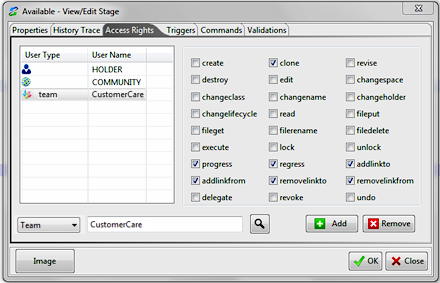
| Action |
Description |
| create |
Create a new (original/revised/cloned) object
instance. When you add a new object you can set the initial
stage; if this stage allows the creation access, the object
can be created in this stage. Usually only the first stage in
a lifecycle is enabled for the creation and only for a specific
team or assignment (when objects are created, the holder is
the one performing the function). You can create the object
only if the class is not abstract and not hidden. |
| clone |
Create a clone of a selected
object instance; the action is allowed only if the user has
the clone access for the reference object (in the current stage)
and the create access to add the new instance. The new object
will be of the same object class. |
| revise |
Create a revision of a selected object instance;
the action is allowed only if the user has the revise access
for the reference object and it is revisionable (in the current
stage), and he has the create access to add the new instance.
The new object will be of the same object class and will inherit
the same name. |
| read |
Allows a user to view the properties
of an object, including field values, the history, etc. If a
user has not the read access he can only see the basic properties
(class, name, revision, holder, currentstage, lifecycle, locker)
while the other will be hidden by a '#####' string. |
| edit |
Edit the description and the field values of an
object |
| execute |
Execute a method (or program)
defined for the object's class |
| changespace |
Move the object from a space to another |
| changeclass |
Change the class for the object
instance. The operation is allowed if the new class is not abstract
and not hidden and the lifecycle supports it. Values for fields
that are not in common between the old and the new class will
be lost. |
| changename |
Change the object name (and revision). You cannot
change revision without revise the object or change also the
object name. |
| changeholder |
Change the object holder or update the alternative holder list. |
| changelifecycle |
Change the object's lifecycle (and stage). You
can change the object stage by performing a progress or a regress
action, or changing also the object lifecycle. |
| addlinkfrom |
Allow the object to be the "from"
side of a link with another object [out-link].
To edit the link field values, you need the same access rights
for the link creation |
| addlinkto |
Allow the object to be the "to" side
of a link with another object [in-link].
To edit the link field values, you need the same access rights
for the link creation |
| removelinkfrom |
Remove a link from the current
object to another [out-link] |
| removelinkto |
Remove a link from another object [in-link]
|
| fileput |
Attach files to an object instance, lock and unlock single files.
The operation is allowed if the object is not locked by another
user. |
| fileget |
Allows the user to extract an attached file from
an object instance and save it to a local folder or open it
with an editor |
| filerename |
For an object's attached file,
permit to change the filetype or the name or move to another
filespace. The operation is allowed if the object is not locked
by another user. |
| filedelete |
Delete an object's attached file. The operation
is allowed if the object is not locked by another user. |
| lock |
Disable other users to edit
the object, change the current stage or to work with its attached
files. The operation is allowed if the object is not already
locked by another user. |
| unlock |
Release a lock placed on an object by another
user and remove all file locks. Users may release locks they
themselves have placed on objects without this access. This
operation should be reserved to some supervisor user. |
| progress |
Change the object lifecycle-stage
to be that of the next stage. The operation is allowed if the
object is not locked by another user. |
| regress |
Change the object lifecycle-stage to be that of
the previous stage. The operation is allowed if the object is
not locked by another user. |
| delegate |
Grant the access privileges
the user has for an object instance to another user. |
| revoke |
Revoke the access privileges that have been granted
for an object instance. |
| undo |
Restore back the previous values of object fields |
| destroy |
Remove an object from the database.
The operation is allowed if the object is not locked by another
user. |
As said before you can also establish
which actions performed on the governed object in a given stage
are logged into the object history. If you set in the "History
Trace" tab a specific flag, everytime a user performs the
relative action a new record containing the action description,
the event time and the user name, will be added in the history.
The are two level of history settings: at the lifecycle level and at the single stage level; in the first case, the selected flags are valid for all stages and you cannot override the behaviour in the stage mask (selected flags fro the lifecycle are disabled in the history trace panel for stages).
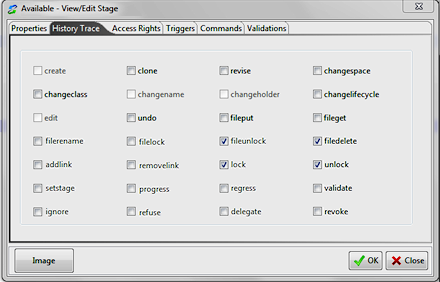
The object status evolves respecting the stage sequence
described by the lifecycle.
If this sequence is linear you know every time what is the next
stage respect to the current stage. However, in most cases the stage
diagram may be more complex; for example you can take into account
the possibility to jump to other stages out of the main sequence.
When more branches take origin from a stage, you have to select
the next stage during the progress operation. In OBEROn, "validations"
are a way to control the change of an object’s stage. A validation
definition is necessary every time you have more than one path from
a given stage: each path will have at least one validation.
Validations can be associated with user, team or assignment. When
a validation is required for a path, a user must validate the object
in order for the object to move on to the next stage along that
path. If that user does not validate it, the object remains in the
current stage until the user does validate or until someone with
higher authority provides approval.
A validation is characterized by the following parameters:
- the identificative name
- the destination stage (or stagefork)
- the access privileges to define which category of users can validate,
refuse or ignore it
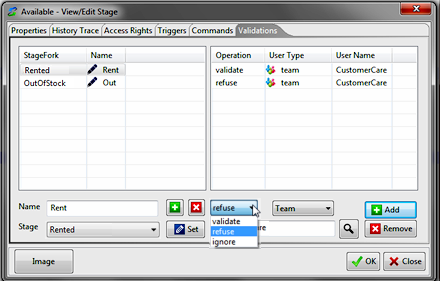
Sometimes a change in stage is controlled by one or
more users when different people are involved in deciding whether
the object is ready for the next state.
In this case more than one validation can be associated with the
transition of an object and when all the validations for a given
path (stagefork) are satisfied [validated or ignored] the object
can be promoted. If the "autoprogress" option is
activated for the current stage, the transition is automatically
performed as soon as the last validation for the destination stage
is satisfied.
When validation is refused, promotion to the next state is prevented
from taking place.
It a user demote the object status to the previous stage, the validation
conditions for the current stage are all kept; you can check the
"autoreset" flag on the Properties panel to enable
the validation signature reset on object status regression.
An equivalent lifecycle
creation OOQL command  might be:
might be:
|
lifecycle define
'MovieLC' description 'Governs the Movie objects'
|
| |
filespace
'Posters'
revisionrule '-'
class 'Movie'
filetype
'JPG' 'PNG'
defaultfiletype
'JPG'
stage 'ComingSoon' description 'Movie will be available
soon' !revisionable |
| |
|
// stage definition |
| |
stage
'Available' description 'Movie is available for rent'
autoprogress !revisionable |
| |
|
history
addlink ,removelink ,progress ,regress
access |
| |
|
|
holder
edit ,fileput
community read ,fileget
team 'CustomerCare' clone ,progress ,regress ,addlinkto ,addlinkfrom
,removelinkto ,removelinkfrom |
| |
|
validation
'Rent' stagefork 'Rented' |
| |
|
|
validate
team 'CustomerCare'
refuse team 'CustomerCare' |
| |
|
validation
'Out' stagefork 'OutOfStock' |
| |
|
|
validate
team 'Administration' |
| |
stage
'Rented' description 'The movie is not available' autoprogress
!revisionable |
| |
|
// stage definition |
| |
stage
'OutOfStock' description 'No more available' !revisionable
...... ; |
|

